
Arquivo para a ‘Pintura’ Categoria
The complexity, the infinite and God
Except for areas such as art and sectors of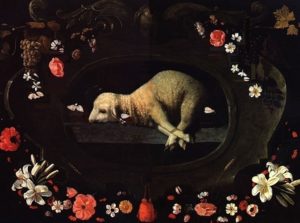 astrophysics, the rest of scientific research is a prisoner of its own methodologies, designed to “maintain the balance of discourse by banishing contradiction and wandering; controlled or guided all developments of thought, but it itself stood out as impossible to solve. ”(Morin, 2008, pp. 80-81).
astrophysics, the rest of scientific research is a prisoner of its own methodologies, designed to “maintain the balance of discourse by banishing contradiction and wandering; controlled or guided all developments of thought, but it itself stood out as impossible to solve. ”(Morin, 2008, pp. 80-81).
It does not mean, of course, to destroy the balance and rationality of human thought, but to let it penetrate: in a sense of the simplest, the most elementary, the most ‘childish’: changing the basis of reasoning, the associative relations, and repulsive among some early concepts, but upon which the whole structure of reasoning and all possible discursive developments depend. And that is, by the way, the most difficult. ” (Morin, 2008, p. 82).
So we start from the “childish” idea of infinity, but which is the great scientific complexity of modern thinking as well, the immensity of the universe that is 96% mass and dark energy is still mysterious, but it may help us and finally the idea that in this infinity there is more than one energy, there is a living Being that precedes the universe itself can be another generous “childish idea”: God.
The eschatology that derives from these two fundamentals, a mysterious universe and a Being that precedes everything (in Christian eschatology is a Trinitarian God, who is also the ‘divine man’ Jesus), can give us a new dialogue in which what we think about matter. , spirit and science can change.
The essential relationship of God through Jesus with the world has as its crucial point the substitution of the metaphor of the lamb that Abraham killed in place of his son (the origin of God’s lamb comes from there), and is manifested by the evangelist John about John the Baptist ( Jn 1:29) who saw Jesus approach and said, “Behold the Lamb of God, who taketh away the sin of the world.”
The Josefa d’Obidos painting that we have already posted here by virtue of building a hologram installation is depicted above.
The Essentials List
We carry too many burdens, not just our bags, bags, even books and too much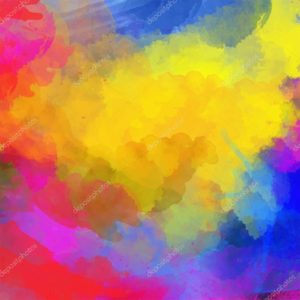 to do, because the contemporary world has difficulty making the list of the essentials.
to do, because the contemporary world has difficulty making the list of the essentials.
Taking care of small household chores, not just leaving them to others, taking work seriously and taking time to rest, also dealing with what can get us out of the stress and anxiety of everyday life, having time for family members and to meditate , contemplate or even just think.
Baroque paintings, paintings and music seem to speak of a still world, too calm for my taste, some would say, but the aspects of flowers, bodegons, and still life indicate something else that is hard to see these days: flow power.
It is not the energy of force, but the energy of soul and spirit, the one that can really put us in the essentials in the face of such a troubled life, full of conflict and contradictory values, even if it is claimed to have difficulty living, it is the flow of everyday life, which is not the flow of life, of energy can be said of baroque art.
Some form of spirituality and inner well-being is responsible for harmony and life on the outside, even though daily life pushes us in the opposite direction, we must have the ability to “get out of the conventional” to make the list of essentials. When we were asked by the apostles to teach them how to pray, we could think of meditating or even just thinking for people who have no religious background.
One can for all indicate the Lord’s Prayer, the one in the “heavens” not far away, but contemplative and in Being.
May his name be holy in present terms, let meditation and contemplation always be present, may your kingdom of peace and harmony come, if not from the outside, to which we are fighting, at least the interior to face conjunctural difficulties.
And lastly, let us work for daily bread, without seeking excess and consumerism, that we may be able to forgive and be forgiven to go beyond the daily conflict. And deliver us from the evil of war, the destruction of nature, and all social ills.
Agnus dei´s Josefa, Óbidos, PT
This main work Josefa d’Ayala and Cabrera, or Josefa d´Óbidos (1630-1684), was a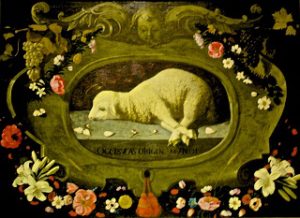 baroque painter in the city of Óbidos, her main work was Agnus Dei, whose painting is in the Évora museum.
baroque painter in the city of Óbidos, her main work was Agnus Dei, whose painting is in the Évora museum.
The painting “Cordeiro Pascal Agnus Dei” was painted between 1660 and 1670 and is in the Museum of Évora, being one of his main works, but it is for the next post.
Its baroque style of still life is characteristic of the period called “Siglo d’Oro” of the arts. There was a new glimpse of nature by integrating floreros, scenes of hunting and representation of animals and still life in the painting.
Strong Iberian influence, among them of Francisco de Zurbarán, see Still Life with Lemons, Oranges and a Rose of the Iberian style of the “bodegóns” and “vases”, of the time.
The Christian influence is also in the work, which can be observed by the grapes, two branches of wheat below and details of the leaves of the vines, besides the Lamb himself.
Josefa, Óbidos, painting Portugal´s barroque
Josefa d’Ayala and Cabrera, a Josefa d’Óbidos (1630-1684), daughter of father, painter Baltazar Gomes Figueira. and Spanish mother D. Catarina de Ayala Camacho Cabrera Romero, noble Andalusian.
painter Baltazar Gomes Figueira. and Spanish mother D. Catarina de Ayala Camacho Cabrera Romero, noble Andalusian.
The father is in danger in Seville in 1626 to follow ephemeral military career. Josefa was the first daughter of her eight children, having been patronized by a famous Sevillian painter, Francisco de Herrera, el Velho. who is the master of Josefa’s father in Spain.
The return to Portugal of Baltazar and D. Catarina, in 1634 (until then made in 4 years), is not a case that the woman returned with her parents and a sister Luisa (born in 1632).
He will probably stay in Seville during his childhood with his father. Juan Ortiz de Ayala, collector and amateur of Fine Arts and his godfather Francisco de Herrera.
Josefa meets the family in Óbidos in 1647. It will be in Coimbra, that realizes its first work: the engraving “Santa Catarina”, signed by Jozepha d’Alla. Coimbra 1646.
It was important for Josefa to stay in Coimbra, in the Augustinian Convent of Santa Ana (1644-47), since it was a great source of information and instruction in the seventeenth century.
It will have been through the office of the father or the convent that Josefa de Óbidos will have had access to an engraving of Italo-Flemish origin, available free of charge in an office of any medium painter of the time, or in the library of any convent.
A short video of RTP shows the work of Josefa de Óbidos:
http://ensina.rtp.pt/artigo/josefa-de-obidos-1630-ou1634-1684/
The spiritual in art, almost forgotten
In addition to Kandinsky, a contemporary recognized as having influence in spiritual art, there are three others almost forgotten: Raymond de Sebonde, author of Natural Theology; Gaudí, creator of the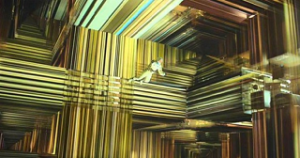 Mediterranean Gothic, and Salvador Dali, incorrectly seen as paranoid-critic, see this in sequence.
Mediterranean Gothic, and Salvador Dali, incorrectly seen as paranoid-critic, see this in sequence.
Dali said after a long phase that he himself said he had a psychological and indirect influence of Freud, to integrate into a new phase, where his frame Christus Hypercubus will be a landmark, and may even relate contemporaneousness with Quantum Physics, the fourth dimension of the universe (the Hypercube), and to a certain extent to the tesseract of Charles H. Hilton.
He says in his Anti-matter Manifesto he writes in all letters: “In the surrealist period, I wanted to create the iconography of the inner world and the wonderful world, of my father Freud … Today, the outside world and that of physics transcended the world of psychology, he declair: “My father today is dr. Heisenberg”, so is a Dali post-surrealism as he proclaims himself.
We have already posted something about this before, but we have developed a little more here.
Proclaimed Dali about his work: “I Dali, re-updating Spanish mysticism, I will prove with my work the unity of the universe, showing the spirituality of all substances,” in which the use of substance is not by chance, even of the physical universe, but may also be that which Teilhard Chardin called the “Christocentric universe,” that is, his Noosphere in the most substantial sense of the word, or in the physical sense of the universe.
This dimension, besides being studied in Particle Physics and Astrophysics, appeared in films like “Contact” (1997, direction of Robert Zemeckis) based on the work of the same name of Carl Sagan, and recently the film Interstellar (direction of Christopher Nolan , 2014), and the possibility of the fourth dimension and the universe being immersed in a hypercube is scientific.
Einstein had predicted a relativistic phenomenon Lense-Thirring (homage to Josef Lense and Hans Thirring) that remained for a long time without proof until this effect began to be detected in artificial satellites and since then has been studied as a real possibility, is a effect of a gyroscope due to the gravitational magnetic field.
The Artefacto 2018 event will begin tomorrow in Lisbon, at Palácio da Ceia, among other works, and will present an Ode to Christus Hypercubs by Dr. Jônatas Manzolli from Unicamp, which will feature pianist Helena Marinho from Aveiro and the soloist Beatriz Maia.
The Monotization of the World
So begins the text of Stefan Zweig on his impression of the contemporary 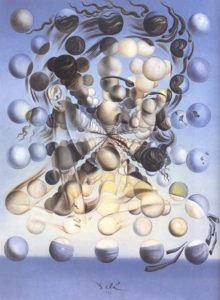 world: “Everything is becoming more uniform in its outward manifestations, all flush with a uniform cultural scheme. The characteristic habits of the individual people are being worn, the native clothing giving way to the uniforms, the customs becoming international.
world: “Everything is becoming more uniform in its outward manifestations, all flush with a uniform cultural scheme. The characteristic habits of the individual people are being worn, the native clothing giving way to the uniforms, the customs becoming international.
Countries seem increasingly to have slid simultaneously to each other; the activity and vitality of people follows a unique scheme; cities grow more and more alike in appearance. “(Zweig, 1925)
With this quotation I also begin the presentation booklet with Dr. Jônatas Manzolli, Professor of Arts at Unicamp, in our joint work: “Transmediatic architecture of the Ode To Christus Hypercubus”, which is presented on fryday at the Palácio de Ceia in Lisbon, with the pianist Dra. Helena Marinho and the soloist Beatriz Maia, both from the University of Aveiro.
This small report intends to present, besides the ode, Photographic work and animation that relate music, images and a hologram in 3D dimensions with an imaginary space hypercube that extrapolates this dimension, inspired by the work of Salvador Dali: Christus Hypercubus.
It is for that reason inspired in the Mystical Manifesto of Salvador Dali of 1950 is a decisive phase and that changes the very conception of Salvador Dali, it can be said for a post-surrealism, in which the mystical influence united the new quantum conception of the emergent Universe (1952) (photo), the Disintegration of Persistence of Memory (1954), The Last Supper (1955), and the Discovery of America (1958-59) are works of this phase.
The Artefacto 2018 event takes place in Lisbon at the Ceia Palace, on November 16 and 17, with several other works that can be found on the event’s website.
ZWEIG, Stefan (1925) “The Monotonization of the World” Disp. em: germanhistoryDocs.gh.dc.org .
There is way, this is a method
Beyond the historical truth, opposed to hermeneutics (Shcleimacher) and romantic historicism (Dilthey), Gadamer deals with the question of truth linked to both religion and art, a transdisciplinary anticipation, and perhaps perhaps its “method” (see our previous post the Ricoeur question), put it this way: “A cultured society that has fallen away from its religious traditions expects more from art than the aesthetic consciousness and the ‘standpoint of art’ can deliver.
with the question of truth linked to both religion and art, a transdisciplinary anticipation, and perhaps perhaps its “method” (see our previous post the Ricoeur question), put it this way: “A cultured society that has fallen away from its religious traditions expects more from art than the aesthetic consciousness and the ‘standpoint of art’ can deliver.
The Romantic desire for a new mythology… gives the artist and his task in the world the consciousness of a new consecration. He is something like a ‘secular saviour’ for his creations are expected to achieve on a small scale the propitiation of disaster for which an unsaved world hopes.” (Gadamer, 1989), of course, salvation here would be earthly and not heavenly.
In fact, it is what we understand by history that makes us skating at levels of tradition, says Gadamer on history “In truth history does not belong to us but rather we to it.” (Gadamer, 1989)
Gadamer explains the difficulties not only historical, but mainly the prejudices linked to tradition: “It is the tyranny of hidden prejudices that makes us deaf to what speaks to us in tradition.” (Gadamer, 1989)
And agree in this dialog´s difficult: “We cannot understand without wanting to understand, that is, without wanting to let something be said…Understanding does not occur when we try to intercept what someone wants to say to us by claiming we already know it.”
It indicates how to put this into practical and real plans: “What man needs is not just the persistent posing of ultimate questions, but the sense of what is feasible, what is possible, what is correct, here and now. The philosopher, of all people, must, I think, be aware of the tension between what he claims to achieve and the reality in which he finds himself.” (Gadamer, 1989)
It is necessary to foresee (virtually) possibilities, but to be able to adapt them within the real possibilities, so there is no romantic hermeneutics or historicism, both must bear in mind the realities and interpret them.
Gadamer, H.G. Truth and Method, 2nd edn, Sheed and Ward, London 1989.
The Schelermer triadric ballet
Many are the biographical possibilities for Oskar Schlemmer (1888-1943), to understand Schelemmer’s humanism, beginning with his discipline “The Man” which he taught at the Bauhaus in “Teaching Matters: Man”, aiming to “familiarize apprentice with the whole man, making it from two distinct types of consideration: the visible trimming and its presentation “, as it appears in the site: www.tipografos.net/bauhaus/.
The idea of the triadric bale comes from three participants (two male and one female), 12 dances and 18 costumes, there is strong puppet theater influence, the idea of machinic movements, synthesis of his vision of modernity divided into two main movements : the mechanization, which makes man as a machine and the body a mechanism, and, the primordial impulses, the depths of our creative impulses.
He saw in the choreographic geometry of dance a synthesis, the Dionysian and emotional origins of dance, which made it rigid and apolytic in its final form, but wanted to be free from the historical baggage of opera and theater, and thus see the man transformed by the costume and dance.
He saw puppets and puppet movements as human beings, reading from the virtual would say that he has a “grammar”, and using a reasoning Schelemmer can be said that “the medium of all art is artificial”, and therefore , a virtual artifact.
In analyzing the body as geometry: it saw the head and eyes as circles, so the body becomes a figurine from which the costume derives, and finally, the movements of dance and music emerge from there, forming the “whole” of man where we began the analysis of his work.
Born on September 4, 1888, he would be 130 years old today, the reason he’s in Google.
The mystic Dali is little known
Salvador Dalí’s painting Christus Hypercubus, of 1954, created the fourth dimension of understanding in painting the fourth dimension and the quantum universe.
painting the fourth dimension and the quantum universe.
The mystical idea of Salvador Dalí described in the picture Christus Hypercubus was already present when in 1951 he had already written the Mystical Manifesto, in this picture Jesus Christ appears hovering over the space ahead of a Cross in the fourth dimension, there are no nails, with a woman in front of the cross, whose model would have been Dali’s wife.
Cubists like Pablo Picasso had attempted to paint four-dimensional forms on two-dimensional canvases, the theories of mathematicians Bernhard Riemann and Henri Poincaré that came out of the conventional forms of straight lines and planes, and were their inspirations, but Dali went further in his early descriptions of his painting he called them painting “metaphysical and transcendent cubism”.
But he did not fail to make references to the thirteenth-century architect Juan de Herrera and to the Ars Magna treatise of the 16th-century Catalan philosopher and alchemist Raymond Lull.
Dali will explore theories of theoretical physics until his death in 1989, proving this was the contact maintained for years with the mathematician Thomas Branchoff of Brown University, and despite the initial refusal in 1975, it ended up becoming a long collaboration of almost one of each.
According to Banchoff: “Lull was a Catalan who studied two dimensions, two centuries later, Herrera took it to the third dimension. Here’s Dalí in a straight line, taking it to the fourth dimension, “Banchoff said, adding,” they were not thinking of it as a four-dimensional cube unfolded – it came a century or two later. ”
But the Hypercube or Tesseractus actually had the intention of painting the fourth dimension, and Dali wrote in his Anti-matter Manifesto in 1958: “In the surrealist period I wanted to create the iconography of the inner world and the wonderful world of my father Freud … Today, the outside world and that of physics have transcended the world of psychology. My father today is dr. Heisenberg “referring to the creator of the first concepts of quantum physics”.

